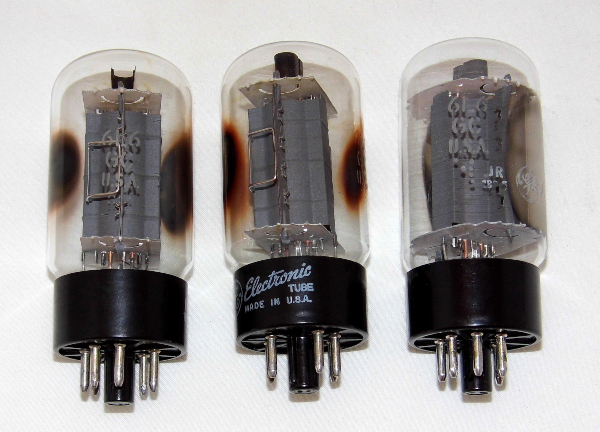NOS Tubes – The hype, myth, and reality.
Are NOS tubes any better or different than the new tubes made today? Many folks cannot seem to tell the difference. After a recent batch of new tube testing, where NOS tubes are used as a standard for some areas of the test, I thought some explanation of this subject was warranted.
Why can’t some folks hear and feel the difference? This is actually pretty easy to explain. A lot of today’s players, especially the younger ones, have never played an amp from the Fender Tweed era. These amps had simple circuits and lower gain. Playing one of these amps yields a feel that cannot be approached in higher front end gain amps. The higher the gain, the less articulation, harmonic content, and frequency response in many cases. These vintage design amps also would sustain at low volume levels, or most any volume level.
You don’t want to accept this? Try this simple test. Take your high gain amp, turn the master way down, and the gain pretty far up. Hit a nice power chord, and while the chord is ringing, hit a note or two? in a lot of amps one will barely hear the added notes. Crank the gain all the way up now. In a lot of amps, the sound has become so indistinct, that even chord changes are difficult to discern.
Vintage amps and vintage circuits have a different tone and the amp plays differently. Most of the younger generation have not had a chance to play some of these amps if any of them. It is like making comments on how fast a Ferrari BB512 is as you watch from the curb. It is different than making the comments after sitting in the driver’s seat.
So, the hype of NOS tubes? The hype is generally the comments from folks that plug a nice NOS tube in their very high gain amp and crank it up. These folks need to spend a bit of time and also learn what to listen for such as harmonic content, life in a note that is held, and body and depth in the notes.
The reality of NOS.
There are many factors, but economics and lawsuits and liability, and the EPA are two of them today.
Liability? You bet. The money goes to safety. Cars? airplanes, etc. This boils down to STEEL. Yup, That stuff your car body is made of, turbine blades in jet engines are made of, etc.
Steel was really coming into it?s own around World War 1. Submarines needed metals that could be compressed at depth over and over. Airplanes need crankshafts that could stand up to their job. Metallurgy continued to improve. There were great steel companies such as US Steel in the USA, and the fine Swedish and Finnish steels. Today, most of the US steel companies are gone. The great controlled steel recipes are reserved for more critical applications such as aerospace or the automotive and aircraft industries, where a lawsuit is just around the corner. If a tube fails in an amp, who cares?
The EPA makes the production of cathode coatings and like items more costly and at times almost impossible.

Then, there is economics from a geographic point of view. The Russians are not cranking out defense equipment anymore. They have no money. One batch of steel is completely different than the next batch. In Eastern Europe, it is the same when it comes to the quality control of metal alloys. There is little economic reason to have high-quality control standards in a cheap vacuum tube.
When tubes were used in scientific, medical, and defense equipment, the quality was an issue. Today it is not an issue.
So, where does this get us?
Today’s new tubes are very inconsistent. Their specs run plus to minus 50%. They are not linear (those plate alloys react differently as the frequency changes and heat changes for one thing), and they do not meet the specification that was established in 1957. They may meet one spec., but only if you are lucky. Recently I tested some new Sovtek 12AX7LPS tubes. These brought this subject home. Using a myriad of test equipment, it was found that in one area, these tubes did beautifully. This area was a simple gain. Using the Vacuum Tube Valley small tube characterizer, these tubes produced the gain of 100 or over a bit in some cases, just as a 12X7 should. BUT a tube has more than one factor.
Gain. Think of gain as horsepower. Just like cars today, some have a lot of horsepower via small displacement and turbocharging. It took a few decades to get back horsepower into cars on the road after the gas crisis of the seventies. There are big dollars in cars, and consumers wanted horsepower and performance. Over the years, even with CART standards, we got back horsepower. We got little else initially, but with all those
consumer dollars at stake, by late 1990?s we also got back overall performance.
Today’s tubes have gain.
They may not have linearity (driveability), but they have gained, in varying degrees.
Output. Think of this as torque. This is one thing today?s tubes are lacking. The output is what pushes your signal through an ever-expanding load of
resistors, signal processors, effects, and tons of additional circuitry in your signal chain. Look at these three and four-channel amps, where V1 (your first gain stage and the mother of your tone), is expected to drive the rest of that mess of a signal path.
You can look at that Sovtek 12AX7LPS that had a gain of 100 or 105 in some cases, out with an output of 0.5 – 0.6 milliamps, it had half the expected output of a good 12AX7.
Today’s tubes do not have output.
Transconductance. Think of this as acceleration. The ability to react to a signal (or green light) and get off the line fast, slow down, speed up,
and take the corners. This also relates to how linear tubes response curves perform. With a nice linear response, note changes have the same levels. If this factor is lacking, you are fighting your instrument trying to compensate for its non-linear character. Again, the Sovtek 12AX7LPS did not perform even close to 1957 or NOS spec.
By the way, the Sovtek 12AX7LPS is a great tube by today’s standards and performs better than a lot of them out there.
So, this third factor, TC or acceleration, is also missing. Where does that leave us?
NOS, for one thing, is a short term option. Short term? Sure, this is limited stock. The reason the 50’s tubes fare better than the 60’s tubes in some cases, and the 60?s better than the 70?s, and so on, was that in the ’50s, more tubes were used for critical applications. They had better metals and QA.
There are some points of light on the horizon too.

Well, thankfully, the Chinese have money and are putting it into consistency. They see the economics of the music business as a strong market with MTV, VH1, CMT, and more amp makers than ever before in music history. Each Chinese batch of 12AX7?s is better than the next. Their torque and acceleration? are currently better and closer than any of the Europe tubes generally. Their consistency is also the highest.
The last hope lies in the hands of folks like Aspen Pittman (Groove Tubes). GT spent a LOT of money to remake a tube called the 6L6GE as an example. This was not an easy task, taking years. Using the original tooling was not all that hard (Aspen just bought it from a factory when it shut down), but setting it up properly was another costly story. Then the daunting tasks of those materials in the recipe were the issue. Well, he pulled it off, after many years and many dollars. We now have a great NVM ( I coined that NVM by the way ? new vintage manufacture) output tube. It is not cheap, but it can be produced over and over now. I am not too worried personally on how long this tube can be produced, as I am 53, and I saw enough tonnage of original plate material metal to make enough of these to last at least my lifetime!
There are other folks that work directly with some of the major tube factories. Some do this for a love of tone and amps, such as Aspen, some do
it for economics. The folks that do this for economic reasons seem to take shortcuts that show up in the end result product, as is the case in some of today’s preamp tubes.
When it comes to new preamp tubes, keep in mind that today you have gain? although all over the scale and inconsistent. You rarely have other factors, output, and TC. If you know your preamp tube vendor, your chances with new tubes are much better. GT, as an example, tosses about 50% of their tubes, as they have to meet tests for output, low noise, and a lack of microphonics. That is part of the reason for their cost that some folks feel is higher than some untested tubes.
Conclusion
The bottom line here is that NOS tubes were superior to the products made today. If you cannot hear this and FEEL this, turn down your gain, raise your master, maybe learn what to listen for, and perhaps have your ears cleaned.
If after all that, you still feel there is not a difference, then you are fortunate to have standards that are easily met. BUT ?. You still cannot escape the basic math and see that the data on today’s tubes do not meet those of yesterday unless you have a vendor that will go through 1000 of them to find a few great ones.







